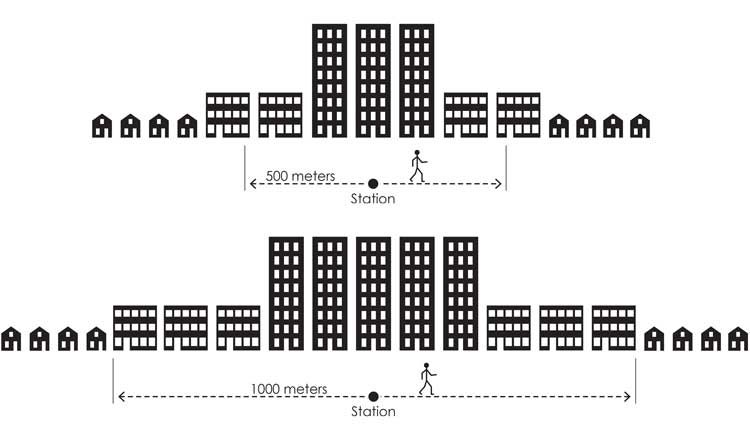
Ending Global Sprawl: Enhance Shared Mobility and Transit
This article was originally published in Ending Global Sprawl: Urban Standards for Sustainable and Resilient Development, written by Peter Calthorpe and published by the World Bank's Global Platform for Sustainable Cities. Ending Global Sprawl explores forward-thinking planning strategies for the urban form.
Principle 3: Enhance Shared Mobility and Transit
Make networks of transit, new forms of shared mobility, and active transport more desirable, affordable, and ubiquitous.
Rationale and Challenge
Transit and new forms of shared mobility must be at the heart of transportation in the next generation of cities. Private occupant vehicles—even electric and autonomous — cannot make our communities livable nor sustainable. Forms of shared mobility range from traditional grade-separated Metro systems or at-grade light rail and new forms of bus rapid transit (BRT) using autonomous technology to basic bus service and informal jitney service. Regardless of the mode, the key to high ridership is frequent service and exclusive rights-of-way to make transit trips time competitive with autos. Making such a range of transit accessible and an option that works across all levels of income is one of the best ways to reduce car dependence.
Many of the greatest cities are known for their public transit systems; Tokyo, London, Hong Kong, and Singapore are excellent examples. In these places, most commutes are by transit, not cars, even though large fractions of the population are affluent and can afford to drive. In these places where robust public transit systems are possible, transit networks must be well integrated with walking, biking, and other forms of micro-mobility to solve the “last-mile” question of how people will get to their final destination.
An important transportation design consideration is the growing role of low-income sprawl in developing economies. As developing cities become more populated and more expensive, many low-income residents cannot afford housing in the dense, central urban areas coincident with better access to transit. Throughout the world, the poor suffer most with long, slow commutes. In Mexico City, many living at the urban edge commute up to three hours each way to work, relegated to low-quality and inefficient informal bus systems. This consequence of sprawl will continue to be an obstacle to mobility among lower-income groups and a challenge to be addressed in cities’ relationships between public transportation and land use.

Goals and Actions
3A: Ensure frequent and direct transit service with an interconnected hierarchy of transit technologies
- ACTION 1: Integrate Metro, bus rapid transit, light rail, streetcar, and bus service with micro-mobility options
- ACTION 2: Build a cross-service, smart transit access system
- ACTION 3: Coordinate transit so it is easy to switch modes or lines; limit transfer distance to 100 meters
3B: Locate transit stations within a walking distance of homes, jobs, and services
- ACTION 4: Locate transit lines and expansions to service all new and redevelopment areas
- ACTION 5: Plan a grid of dedicated transit lanes that can be used for BRT, light rail, streetcar, or autonomous shared vehicles
- ACTION 6: Emphasize the bike connection to major transit stations
Metrics
3.1: Transit Plans
Create a transit plan which ensures that megacities have a public transit mode share of 35%, big cities have 30%, and small- and medium-sized cities have a public transit mode share of 25% or more
3.2: Distance to Transit
All major housing and job centers should be within 500 meters of a local transit station and 1,000 meters of transit service with exclusive right-of-way

Benefits
Economic
- Decreases cost of congestion: High-quality public transportation shifts commuters away from energy-intensive private vehicles, which reduces traffic congestion.
- Increases property values: Being located near transit increases real estate values. Proximity to public transit stops has led to price premiums of 11% in Hong Kong, 14% in Bogota, and an annual increase of 2.3% in Beijing.
- Decreases transportation costs: People living in cities with the best public transportation systems spend less of their household budgets on transportation. This contributes to the overall affordability of compact cities.
Environmental
- Decreases carbon emissions: Effective public transit systems decrease emissions. For example, transportation-related emissions are 30% lower in China’s Hankou district, with its compact urban fabric and good transit in comparison to the Hanyang district, that is characterized by low road density and a high proportion of car commuters.
- Improves air quality: Public transit produces less CO2, NOx, and PM2.5 than car travel.
Social
- Increases access for disadvantaged groups: High-quality public transit can improve transit times and accessibility of transportation for people of all ages and income groups.
- Lowers crash risk: Transit travel has about one-tenth the rate of crash deaths or injuries as car travel.
- Builds social ties: Compared to car travel, public transit is a shared experience, thus helping to build social ties and community.
About the Author: Peter Calthorpe

Peter’s long and honoured career in urban design, planning and architecture began in 1976, combining his experience in each discipline to develop new approaches to urban revitalization, suburban growth and regional planning. In 1983, Peter founded the award-winning firm of Calthorpe Associates devoted to sustainable urban design and planning globally. In May 2019, Calthorpe Associates joined HDR. Throughout his career in urban design, planning and architecture, he has been a pioneer of innovative approaches to urban revitalization, community planning, and regional design. For his contribution in redefining the models of urban and suburban growth, he was awarded Urban Land Institute's prestigious J.C. Nichols Prize for Visionaries in Urban Development in 2006. He is one of the founders and the first board president of Congress for the New Urbanism. Metropolis Magazine claims: "The titles of Peter Calthorpe’s books define the recent history of urban design in its most vital and prescient manifestations."

